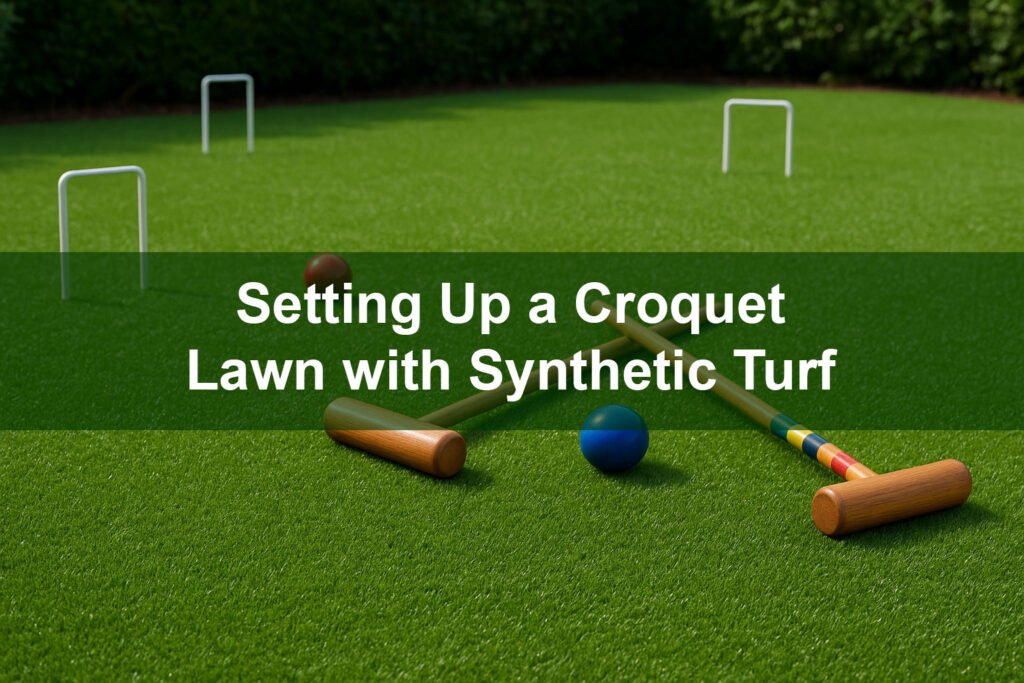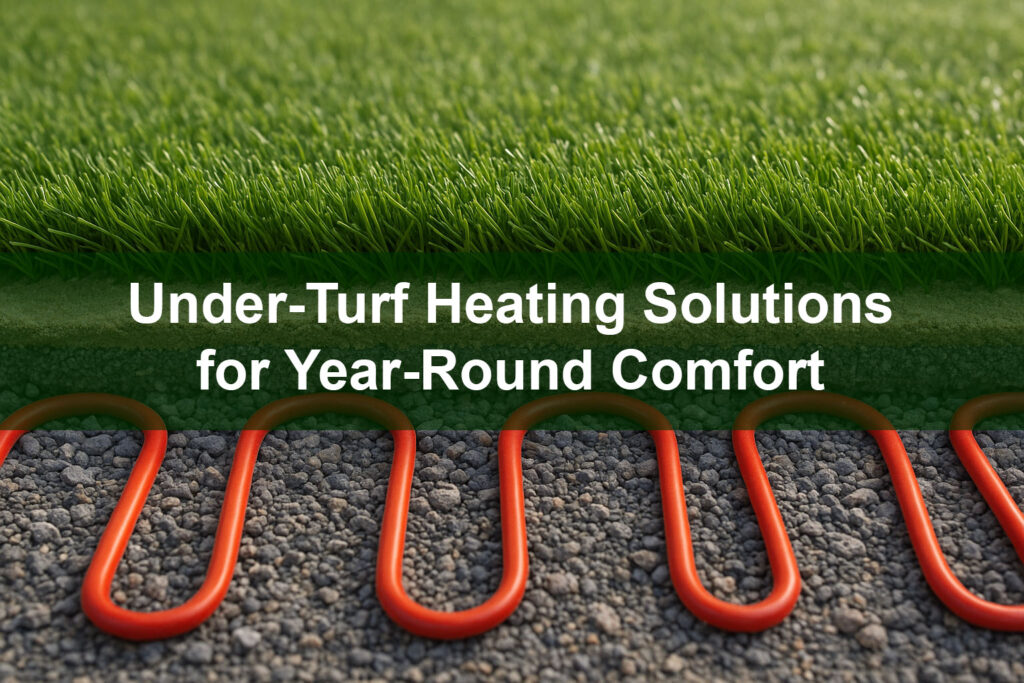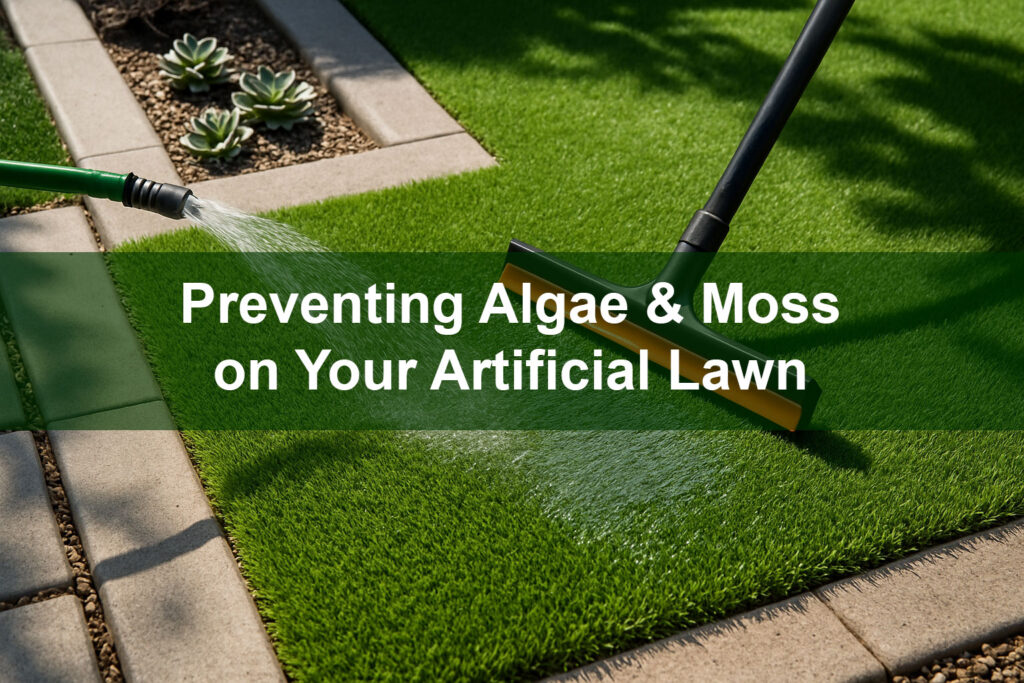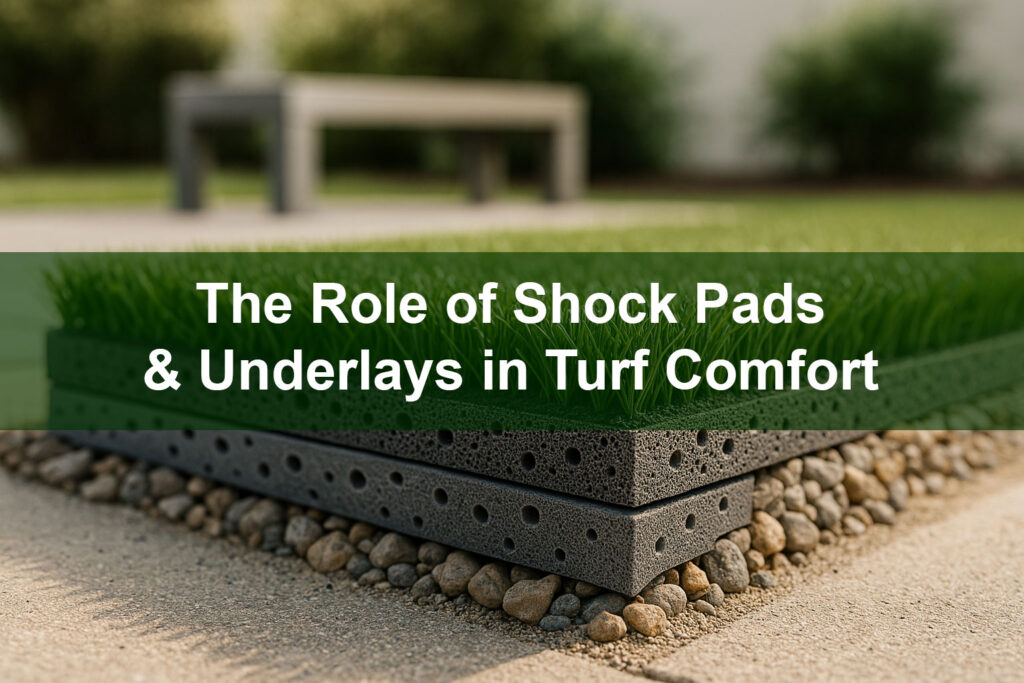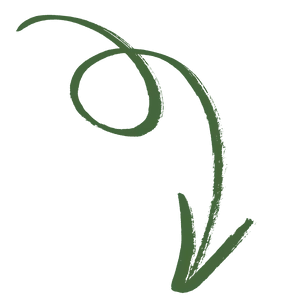Maintaining a clean and germ-free artificial lawn is essential for a safe and healthy outdoor space.
Whether you’re a homeowner, pet owner, or business, understanding how to disinfect artificial grass helps prevent bacteria buildup, odors, mold, and potential health risks.
Many people struggle with selecting the right cleaning products and effective sanitation methods without damaging their turf.
This guide provides practical solutions and best practices to help extend the life of your artificial grass, keep it looking great, and ensure a hygienic environment.
What You’ll Learn in This Article:
- Why Regular Disinfection of Artificial Grass is Essential
- Common Problems When Cleaning Artificial Grass
- The Best Cleaning Solutions for Artificial Grass
- Step-by-Step Guide to Disinfecting Your Artificial Grass
- How to Prevent Bacteria and Odors in Artificial Turf
- Natural vs. Chemical Disinfectants
- Maintaining a Long-Term Cleaning Routine
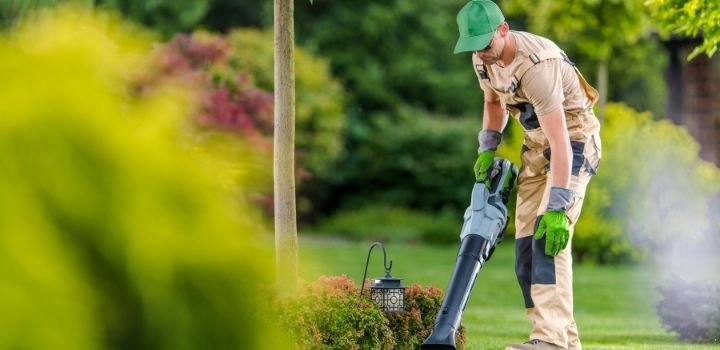
Why Regular Disinfection of Artificial Grass is Essential
Artificial grass is continuously exposed to dirt, bacteria, pet waste, and environmental elements that can lead to unpleasant odors, unsightly stains, and potential health hazards.
Over time, without proper care, bacteria and fungi can accumulate, creating a breeding ground for germs and allergens.
Ensuring routine cleaning and disinfection is crucial for maintaining a hygienic and aesthetically pleasing artificial lawn.
For professional artificial grass cleaning and maintenance services, visit our Lawn Solutions page.
Key Benefits of Regular Disinfection:
- Prevents bacteria, mold, and mildew growth – Reduces health risks and keeps your turf fresh.
- Eliminates pet odors and urine buildup – Neutralizes unpleasant smells and prevents bacterial contamination.
- Extends the lifespan of your artificial turf – Helps maintain the durability and integrity of synthetic fibers.
- Maintains a safe and hygienic play area for kids and pets – Reduces exposure to harmful microorganisms and allergens.
- Enhances the overall appearance of your landscape – Keeps your lawn looking clean, vibrant, and well-maintained.
- Reduces the risk of slippery surfaces – Prevents algae and mildew buildup that can create hazardous, slick spots on the turf.
Regular disinfection, when combined with proper maintenance, ensures your artificial grass remains a long-lasting and hygienic outdoor solution for residential and commercial spaces.
This guide offers comprehensive tips on maintaining artificial grass, including debris removal, rinsing, and pet waste management. It emphasizes the importance of regular cleaning to prevent bacteria buildup and odors.

Common Problems When Cleaning Artificial Grass
When it comes to disinfecting artificial turf, many homeowners and businesses face these common challenges:
- Buildup of Bacteria and Germs – Artificial grass can trap bacteria, fungi, and allergens, especially in damp or shaded areas where moisture lingers. Without regular disinfection, harmful microorganisms can spread, creating potential health risks for both humans and pets.
- Pet Waste Odors and Stains – Urine and feces left on artificial grass can quickly develop strong odors and attract bacteria. If not cleaned properly, the waste can seep into the turf backing, making it more difficult to remove the smell and sanitize the area.
- Choosing the Right Disinfectant – Many people struggle with selecting a cleaning solution that is both effective and safe. Harsh chemicals like bleach can damage synthetic grass fibers, while weak or natural solutions may not fully eliminate bacteria, leading to ineffective sanitation.
- Residue and Product Buildup – Some disinfectants and cleaning products leave behind sticky residues that can attract dirt and debris. Over time, this buildup can make the turf look dull, reduce its softness, and require frequent deep cleaning.
- Proper Rinsing and Drainage Issues – Artificial grass should be rinsed thoroughly after cleaning to remove any remaining product. However, poor drainage can cause water to pool, increasing the risk of mold and mildew growth, rather than eliminating bacteria.
- Sunlight Exposure and Heat Retention – Artificial grass retains more heat than natural grass, particularly in direct sunlight. High temperatures can cause disinfectants to evaporate too quickly, making them less effective at killing germs and leaving surfaces improperly sanitized.
- Balancing Frequency of Disinfection – Over-cleaning artificial turf with harsh disinfectants can lead to fiber degradation, reducing the lifespan of the grass. On the other hand, infrequent cleaning allows bacteria, mold, and odors to accumulate, making future maintenance more difficult.
For pet-friendly artificial grass solutions, explore our Pets Turf page.
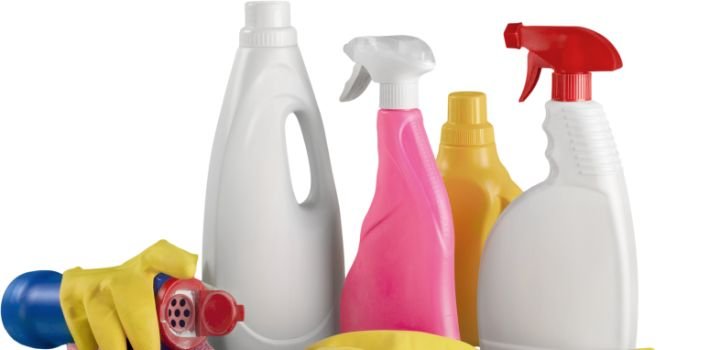
The Best Cleaning Solutions for Artificial Grass
Choosing the right cleaning solutions is crucial to maintaining a safe and fresh artificial lawn.
Various cleaning agents can help disinfect your turf while ensuring it remains in top condition.
Below are some of the best options to consider:
1. Vinegar and Water Solution
A 50/50 mix of white vinegar and water is a natural and effective way to disinfect artificial grass. Vinegar helps kill bacteria, neutralize odors, and remove mold or mildew without damaging the turf fibers. Simply spray the solution over the surface, let it sit for 10-15 minutes, and rinse thoroughly with water.
2. Mild Dish Soap and Water
For routine cleaning, a small amount of mild dish soap mixed with water can help lift dirt and grime. Use a sponge or soft-bristle brush to scrub any dirty areas gently before rinsing with a garden hose.
3. Enzyme-Based Cleaners
These specialized cleaners are designed to break down organic matter such as pet waste and urine. Enzyme-based cleaners neutralize odors at their source without harming artificial grass. They are particularly useful for pet owners.
4. Hydrogen Peroxide (Diluted Solution)
A diluted hydrogen peroxide solution (one part hydrogen peroxide to four parts water) is a powerful disinfectant that can eliminate bacteria and mold. Spray evenly across the turf, allow it to sit for a few minutes, and rinse well.
5. Artificial Grass Disinfectant Sprays
Commercially available artificial grass cleaners are specifically formulated to kill bacteria, remove odors, and maintain the integrity of synthetic turf. These are often available in ready-to-use spray bottles for easy application.
What to Avoid
- Bleach and Ammonia-Based Cleaners – These can weaken artificial turf fibers and create harmful fumes.
- Pressure Washing – High-pressure water can dislodge infill and damage the turf backing.
For high-quality cleaning solutions and artificial grass maintenance tools, visit our DIY Artificial Grass page.
- Step-by-Step Guide to Disinfecting Your Artificial Grass
- How to Prevent Bacteria and Odors in Artificial Turf
- Natural vs. Chemical Disinfectants: Pros and Cons
- Maintaining a Long-Term Cleaning Routine
- Conclusion & Call to Action
For additional expert insights on maintaining artificial grass, check out our Ultimate Guide to Cleaning Artificial Grass.

Step-by-Step Guide to Disinfecting Your Artificial Grass
Properly disinfecting artificial grass ensures a safe, clean, and hygienic environment for homeowners, businesses, and pets.
Follow these simple steps to maintain a germ-free artificial lawn:
- Remove Debris – Use a leaf blower, stiff brush, or rake to remove leaves, dust, and other debris.
- Rinse the Grass with Water – Use a garden hose with moderate water pressure to wash away dirt and prevent buildup.
- Apply a Cleaning Solution – Use a safe disinfectant like diluted vinegar, mild soap, or an enzyme-based cleaner. Avoid using harsh chemicals like bleach.
- Scrub Stubborn Areas – Use a soft-bristle brush to clean heavily used sections or areas affected by spills and stains.
- Let the Solution Sit – Allow the disinfectant to work for about 10-15 minutes to break down bacteria and odors.
- Rinse Thoroughly – Wash off the cleaning solution with fresh water to prevent any residue buildup.
- Allow the Turf to Dry – Let your artificial grass dry naturally under the sun, which helps to eliminate lingering bacteria and odors.

How to Prevent Bacteria and Odors in Artificial Turf
Keeping your artificial grass free from bacteria and odors is essential for maintaining a clean, fresh, and safe outdoor environment.
Regular maintenance and proper sanitation practices ensure your turf remains durable and hygienic for years to come.
Here are some key preventative measures to consider:
- Pick up pet waste daily – Promptly removing solid waste prevents bacteria from spreading and reduces odor buildup. Rinse urine spots with water to dilute residues and prevent ammonia buildup.
- Use a turf deodorizer – Specialized artificial grass deodorizers contain enzymes that help break down organic matter, neutralizing lingering odors caused by pet waste, mold, and mildew.
- Encourage proper drainage – Ensuring that your artificial turf is installed with proper drainage prevents water from pooling, which can create an environment for bacteria and mold growth. Regularly check and clear drainage systems to allow water to flow freely.
- Brush the grass regularly – Using a stiff broom or a specialized turf brush helps maintain even distribution of infill and prevents matting. This also improves air circulation, which helps to dry moisture-prone areas faster and reduces bacteria buildup.
- Apply a weekly vinegar-water rinse – A natural disinfecting solution of equal parts white vinegar and water is an effective way to sanitize artificial grass. Spray the solution evenly across the surface, allow it to sit for a few minutes, and then rinse with water to remove bacteria and odors.
- Avoid overwatering – While occasional rinsing is necessary to remove debris and freshen up the turf, excessive water can lead to moisture retention, creating an ideal breeding ground for mold and bacteria.
By implementing these simple yet effective strategies, you can keep your artificial grass odor-free and in excellent condition, ensuring a safe and enjoyable outdoor space.
To find high-quality artificial grass and maintenance tools, visit our DIY Artificial Grass page.
This article offers a step-by-step guide on cleaning and sanitizing synthetic turf, highlighting the use of pet-safe sanitizers and proper rinsing techniques to maintain hygiene.
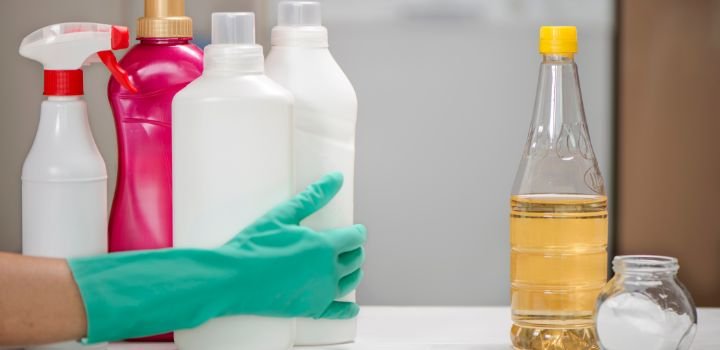
Natural vs. Chemical Disinfectants
Choosing between natural and chemical disinfectants depends on safety, effectiveness, and environmental impact.
Here’s a breakdown:
Natural Disinfectants
- Eco-friendly and safe for pets & kids – Vinegar, baking soda, and enzyme-based cleaners do not contain harmful chemicals.
- No harsh residues or fumes – These options are gentle on the turf and safe for regular use.
- Requires more frequent applications – Natural solutions may need to be applied more often compared to chemical disinfectants.
Chemical Disinfectants
- More effective against tough bacteria – Chemical cleaners can eliminate stronger bacteria and mold.
- Long-lasting results – Requires fewer applications than natural solutions.
- Can degrade artificial turf over time – Frequent use of harsh chemicals like bleach may cause damage.
- May require thorough rinsing – Some chemical disinfectants leave behind residues that need to be washed off completely.
For a balance between safety and effectiveness, use a mix of natural solutions for routine cleaning and occasional chemical disinfectants for deep sanitation.
If you’re looking for high-quality artificial grass products, check out our Outdoor Living page.

Maintaining a Long-Term Cleaning Routine
To keep your artificial grass in top condition year-round, follow this structured maintenance schedule:
Weekly Maintenance:
- Rinse the surface with water – Wash off dust and debris.
- Pick up pet waste and clean affected areas – Prevent bacterial growth and odors.
- Brush the grass fibers – Redistribute infill and maintain the upright position of grass blades.
Monthly Deep Cleaning:
- Apply a mild disinfectant – Eliminate bacteria, mold, and mildew.
- Check for mold or mildew buildup – Treat affected areas.
- Gently scrub high-traffic areas – Remove stubborn dirt.
For professional installation and maintenance services, check out our Artificial Grass Installation page.
Conclusion
Knowing how to disinfect artificial grass is essential for maintaining a clean, fresh, and safe outdoor environment.
By following best practices and using the right disinfectants, homeowners and businesses can prevent bacteria buildup, odors, and turf degradation.
Implementing a consistent cleaning routine ensures that your artificial grass remains visually appealing and functional for years to come.
If you need expert guidance, high-quality artificial grass products, or professional maintenance solutions, contact Buy-Grass today by visiting our Contact Page.
Our team is here to help you keep your artificial grass looking and feeling its best!


